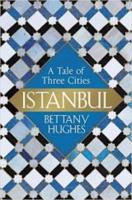
Weidenfeld and Nicolson (2017) h/b 800pp £25.00 (ISBN 9780297868484)
Istanbul is addictive, partly because so much is hidden, though we know it is there. Greeks built on Byzas’ foundation, Romans on the Greek city, Ottomans on the Roman, none with much respect for what they were covering. But bits of earlier ages peep through. Pierre Gilles, French diplomat in Istanbul, 1544-48, recorded the destruction of the Byzantine city, and H. tells us which civic works to approach and which holes to look down to see newly uncovered Greek and Roman finds. Another reason for the city’s addictiveness is the mighty impact of its history on the politics of today.
H.’s book was ten years in the making, and it shows. She clearly wanted a chronological narrative, and marries this remarkably to her examination of key themes. The reader has to bump forward and back a bit as chapter succeeds chapter, but there is little dislocation. The story begins with the contents of the Yarimburgaz Cave, dating from 800,000 BC and ends with the manoeuvres of Erdogan and opposition activity in Taksim Square and on Galata Bridge. In between there are the three cities, Byzantium, Constantinople and Istanbul (though one looks in vain to find this structure in the Table of Contents).
It is not possible to do justice to a history of this magnitude in 800 pages, of course, and there is plenty missing, but H.’s adoption of the broadcaster’s voice (one she knows well), manages expectations nicely. And in a book like this we don’t need to know every activity of every Constantine (11), Maurice or Eirene, but we do need the oblique looks, and the broadcaster’s voice makes the move, for example, from the cult of Mary to the condition of women, or from Byzantine trade to relations with Britain, entirely natural. (The main aspect of Byzantine history which the reviewer looked for, and did not find, was some overview of the long lasting, widely spread and highly damaging recession of the 7th to 9th centuries.)
The broadcaster’s voice also legitimises the indulgence in the odd purple passage; and the presence of alien communities linking east and west in trade, and so enhancing the exotic, olfactory and visual draw of the city, must have been irresistible. It is a delightful book for those who know Istanbul, but what a treat for those who do not, and are considering a visit. H. is an excellent, informed and good natured guide. And there will be a much bigger audience when, surely, this appears as a T.V. series. She manages more than scratching the surface—indeed, she gets under the skin of the great city. Read it alongside Orhan Pamuk’s Istanbul and you might just get near its soul.
Adrian Spooner
